On-Farm Renewable Energy Systems: A Systematic Review
Abstract
1. Introduction
1.1. The Impact and Potential of Renewable Energy Production
1.2. Environmental Considerations
1.3. Importance of RES in Agriculture
1.4. Significance and Possibilities of Energy Self-Sufficiency in Farms
- (a)
- Agricultural by-products have low economic value but great quantity. These factors made the marketization problematic (transportation costs may exceed the real value). Therefore, their local utilization is reasonable, and energy methods have high added (or substitutional) value.
- (b)
- Photovoltaic panels become increasingly important on farms, typically on rooftops and occasionally on the ground. These types of equipment might occupy land (a possible solution may be agrophotovoltaic systems), and fluctuations in electricity production and consumption can cause storage problems, not only in farms but also in national electric networks.
- (c)
- Local renewable energy production could work much more efficiently in complex systems, where sub-systems can use each other’s by-products and produce only marketable outputs. The production of specialized energy crops could also be considered in these systems, which are more expensive than by-products but can produce more energy from a smaller area.
Case Studies in Self-Sufficiency
2. Materials and Methods
2.1. Data Collection and Management
2.2. Data Analysis
2.3. Interpretation
- Global data collection through Scopus is one of the most trustworthy databases.
- Analyzation of title, abstract, literature review, and keywords of articles. Each search result was downloaded in a.csv file containing the following Citation information: Authors, Author IDs, Title, Year, Source title, Volume, Issue, Art. No, Pages, Citation count, DOI, Link, Abstract, Author Keywords, Document type, Open access, and EID.
- Each above-mentioned aspect of the data was analyzed and studied.
- Finally, the connections between countries, authors, annual scientific production, journals, and collaboration networks were analyzed and presented through data visualization.
3. Results and Discussion
3.1. Trend of Publications
3.2. Worldwide Distribution of Publications
3.3. Most Globally Cited Documents
3.4. Keyword Co-Occurrence Network
4. Conclusions
Author Contributions
Funding
Data Availability Statement
Conflicts of Interest
Abbreviations
| AD | Anaerobic digestion |
| APV | Agrivoltaics |
| CH4 | Methane |
| CO2 | Dioxide carbon |
| DOI | Digital Object Identifier |
| EJ | Exajoule |
| eq | Equivalent |
| EU | European Union |
| EU3 | France, Germany and Italy |
| GHG emissions | Greenhouse gas emissions |
| ha | hectare |
| KWe | Kilowatt-electric |
| kWh | kilowatt-hour |
| LCA | life cycle assessment |
| Mm3 | Metric cubic meter |
| Mton | metric ton |
| MWe | Megawatt electric |
| N2O | Nitrous oxide |
| NH3 | Ammonia |
| NOx | Nitrogen oxides |
| OECD | Organization for Economic Co-operation and Development |
| PJ | petajoule |
| RES | Renewable energy sources |
| SDGs | Sustainable Development Goals |
| SJR | Scientific Journal Rankings |
| SO2 | Sulfur dioxide |
| T | ton |
| TC | Total citations |
| TWh | terawatt hour |
| USA | United States of America |
| WPP | Wind power plant |
Appendix A
Academic Literature Search
| Number of Key Words | Key Words Selected |
|---|---|
| KW1 | ((TITLE-ABS-KEY (“renewable energy”) AND TITLE-ABS-KEY (“farm”) AND TITLE-ABS-KEY (“environment”)) AND (EXCLUDE ( DOCTYPE, “cr”) OR EXCLUDE (DOCTYPE, “no”) OR EXCLUDE (DOCTYPE, “ed”) OR EXCLUDE (DOCTYPE, “le”)) |
| Filters | Language: English Sectors: renewable energy, farm, environment, agriculture Country: All countries in the World Type: articles, book, book chapter, reviews and conference papers |
References
- Nyga-Łukaszewska, H. Energy security and sustainable development. In Encyclopedia of the UN Sustainable Development Goals; Springer International Publishing: Berlin/Heidelberg, Germany, 2021; pp. 289–300. [Google Scholar]
- Nguyen, K.H.; Kakinaka, M. Renewable energy consumption, carbon emissions, and development stages: Some evidence from panel cointegration analysis. Renew. Energy 2018, 132, 1049–1057. [Google Scholar] [CrossRef]
- Elum, Z.A.; Momodu, A.S. Climate change mitigation and renewable energy for sustainable development in Nigeria: A discourse approach. Renew. Sustain. Energy Rev. 2017, 76, 72–80. [Google Scholar] [CrossRef]
- Chen, W.M.; Kim, H.; Yamaguchi, H. Renewable energy in eastern Asia: Renewable energy policy review and comparative SWOT analysis for promoting renewable energy in Japan, South Korea, and Taiwan. Energy Policy 2014, 74, 319–329. [Google Scholar] [CrossRef]
- Doğan, B.; Driha, O.M.; Balsalobre Lorente, D.; Shahzad, U. The mitigating effects of economic complexity and renewable energy on carbon emissions in developed countries. Sustain. Dev. 2021, 1, 1–12. [Google Scholar] [CrossRef]
- Edenhofer, O.; Pichs-Madruga, R.; Sokona, Y.; Seyboth, K.; Kadner, S.; Zwickel, T.; Eickemeier, P.; Hansen, G.; Schlömer, S.; von Stechow, C. Renewable Energy Sources and Climate Change Mitigation: Special Report of the Intergovernmental Panel on Climate Change; Cambridge University Press: Cambridge, UK, 2011. [Google Scholar]
- Al-mulali, U.; Solarin, S.A.; Sheau-Ting, L.; Ozturk, I. Does moving towards renewable energy cause water and land inefficiency? An empirical investigation. Energy Policy 2016, 93, 303–314. [Google Scholar] [CrossRef]
- EIA. International Energy Outlook 2019 with Projections to 2050; EIA: Washington, DC, USA, 2019. [Google Scholar]
- Kopetz, H. Build a biomass energy market. Nature 2013, 494, 29–31. Available online: https://www.nature.com/articles/494029a (accessed on 25 November 2022). [CrossRef] [PubMed]
- Dombi, M.; Kuti, I.; Balogh, P. Aspects of the Sustainable Utilization of Renewable Energy Sources. APSTRACT Appl. Stud. Agribus. Commer. 2013, 6, 91–94. [Google Scholar] [CrossRef]
- Primary Energy. 2022. Available online: https://www.bp.com/en/global/corporate/energy-economics/statistical-review-of-world-energy/primary-energy.html (accessed on 20 October 2022).
- WBA. Global Bioenergy Statistics; WBA: Stockholm, Sweden, 2021. [Google Scholar]
- WBA. Global Biomass Potential Towards 2035; WBA: Stockholm, Sweden, 2016. [Google Scholar]
- EASAC. Opportunities and Challenges for Research on Food and Nutrition Security and Agriculture in Europe; EASAC: Halle, Germany, 2017. [Google Scholar]
- Popp, J.; Kovács, S.; Oláh, J.; Divéki, Z.; Balázs, E. Bioeconomy: Biomass and biomass-based energy supply and demand. N. Biotechnol. 2021, 60, 76–84. [Google Scholar] [CrossRef]
- Popp, J.; Harangi-Rákos, M.; Pető, K.; Nagy, A. Bioenergy: Risks to food-, energy- and environmental security. Appl. Stud. Agribus. Commer. 2013, 7, 4–5. [Google Scholar] [CrossRef]
- IEA. Market Analysis and Forecast from 2019 to 2024; IEV: Paris, France, 2019. [Google Scholar]
- Vaish, S.; Kaur, G.; Sharma, N.K.; Gakkhar, N. Estimation for Potential of Agricultural Biomass Sources as Projections of Bio-Briquettes in Indian Context. Sustainability 2022, 14, 5077. [Google Scholar] [CrossRef]
- Nicolae, S.; Jean-Francois, D.; Nigel, T.; Manjola, B. Brief on Biomass for Energy in the European Union; Publications Office of the European Union: Luxembourg City, Luxembourg, 2019. [Google Scholar]
- Ma, X.; Ahmad, N.; Oei, P.Y. Environmental Kuznets curve in France and Germany: Role of renewable and nonrenewable energy. Renew Energy 2021, 172, 88–99. [Google Scholar] [CrossRef]
- Testa, R. An Opportunity for the Agricultural Sector: The Renewable Energy Sources. American Journal of Agricultural and Biological Science 2016, 11, 100–102. [Google Scholar] [CrossRef]
- Szakály, Z.; Balogh, P.; Kontor, E.; Gabnai, Z.; Bai, A. Attitude toward and Awareness of Renewable Energy Sources: Hungarian Experience and Special Features. Energies 2021, 14, 22. [Google Scholar] [CrossRef]
- Bilandzija, N.; Voca, N.; Jelcic, B.; Jurisic, V.; Matin, A.; Grubor, M.; Kricka, T. Evaluation of Croatian agricultural solid biomass energy potential. Renew. Sustain. Energy Rev. 2018, 93, 225–230. [Google Scholar] [CrossRef]
- Rani, P.; Mishra, A.R.; Pardasani, K.R.; Mardani, A.; Liao, H.; Streimikiene, D. A novel VIKOR approach based on entropy and divergence measures of Pythagorean fuzzy sets to evaluate renewable energy technologies in India. J. Clean. Prod. 2019, 238, 117936. [Google Scholar] [CrossRef]
- Bilgili, F.; Ozturk, I. Biomass energy and economic growth nexus in G7 countries: Evidence from dynamic panel data. Renew. Sustain. Energy Rev. 2015, 49, 132–138. [Google Scholar] [CrossRef]
- Jaiswal, K.K.; Chowdhury, C.R.; Yadav, D.; Verma, R.; Dutta, S.; Jaiswal, K.S.; Sangmesh, B.; Karuppasamy, K.S.K. Renewable and sustainable clean energy development and impact on social, economic, and environmental health. Energy Nexus 2022, 7, 100118. [Google Scholar] [CrossRef]
- Ayres, R.U.; van den Bergh, J.C.J.M.; Lindenberger, D.; Warr, B. The underestimated contribution of energy to economic growth. Struct. Change Econ. Dyn. 2013, 27, 79–88. [Google Scholar] [CrossRef]
- Geng, J.-B.; Ji, Q. Technological innovation and renewable energy development: Evidence based on patent counts. Artic. Int. J. Glob. Environ. Issues 2016, 15, 217–234. [Google Scholar] [CrossRef]
- Li, J.; Zhang, X.; Ali, S.; Khan, Z. Eco-innovation and energy productivity: New determinants of renewable energy consumption. J. Environ. Manag. 2020, 271, 111028. [Google Scholar] [CrossRef]
- Su, C.W.; Umar, M.; Khan, Z. Does fiscal decentralization and eco-innovation promote renewable energy consumption? Analyzing the role of political risk. Science of The Total Environment 2021, 751, 142220. [Google Scholar] [CrossRef] [PubMed]
- Ji, X.; Liu, Y.; Meng, J.; Wu, X. Global supply chain of biomass use and the shift of environmental welfare from primary exploiters to final consumers. Appl. Energy 2020, 276, 115484. [Google Scholar] [CrossRef]
- Ladanai, S.; Vinterbäck, J. Global Potential of SustainableBiomass for Energy. 2009. Available online: http://pub.epsilon.slu.se/4523/1/ladanai_et_al_100211.pdf (accessed on 16 September 2022).
- IEA. Potential Contribution of Bioenergy to the World’s Future Energy Demand; IEV: Paris, France, 2007. [Google Scholar]
- IRENA. Global Bioenergy Supply and Demand Projections; IRENA: Abu Dhabi, United Arab Emirates, 2014. [Google Scholar]
- Sayed, E.T.; Wilberforce, T.; Elsaid, K.; Rabaia, M.K.H.; Abdelkareem, M.A.; Chae, K.J.; Olabi, A.G. A Critical Review on Environmental Impacts of Renewable Energy Systems and Mitigation Strategies: Wind, hydro, Biomass and Geothermal; Elsevier: Amsterdam, The Netherlands, 2022; Available online: https://www.sciencedirect.com/science/article/pii/S0048969720380360 (accessed on 26 November 2022).
- Amponsah, N.Y.; Troldborg, M.; Kington, B.; Aalders, I.; Hough, R.L. Greenhouse gas emissions from renewable energy sources: A review of lifecycle considerations. Renew. Sustain. Energy Rev. 2014, 39, 461–475. [Google Scholar] [CrossRef]
- Prakash, R.; Bhat, I.K. Energy, economics and environmental impacts of renewable energy systems. Renew. Sustain. Energy Rev. 2009, 13, 2716–2721. [Google Scholar] [CrossRef]
- Bates, J.; Edberg, O.; Nuttall, C. Minimising Greenhouse Gas Emissions from Biomass Energy Generation. Environment Agency: Bristol, UK, 2009. [Google Scholar]
- Turconi, R.; Boldrin, A.; Astrup, T. Life cycle assessment (LCA) of electricity generation technologies: Overview, comparability and limitations. Renew. Sustain. Energy Rev. 2013, 28, 555–565. [Google Scholar] [CrossRef]
- Sathaye, J.; Lucon, O.; Rahman, A.; Christensen, J.; Denton, F.; Fujino, J.; Heath, G.; Mirza, M.; Rudnick, H.; Schlaepfer, A.; et al. Renewable Energy in the Context of Sustainable Development. Renew. Energy Sources Clim. Change Mitig. 2011, 707–790. [Google Scholar] [CrossRef]
- Hirschberg, S.; Dones, R.; Heck, T.; Burgherr, P.; Schenler, W.; Bauer, C. Strengths and weaknesses of current energy chains in a sustainable development perspective. ATW-Internationale Zeitschrift fur Kernenergie 2006, 51, 447–457. [Google Scholar]
- Fthenakis, V.; Kim, H.C. Land use and electricity generation: A life-cycle analysis. Renew. Sustain. Energy Rev. 2009, 13, 1465–1474. [Google Scholar] [CrossRef]
- Schmidt, J.H. Development of LCIA characterisation factors for land use impacts on biodiversity. J. Clean. Prod. 2008, 16, 1929–1942. [Google Scholar] [CrossRef]
- Campos-Guzmán, V.; García-Cáscales, M.S.; Espinosa, N.; Urbina, A. Life Cycle Analysis with Multi-Criteria Decision Making: A review of approaches for the sustainability evaluation of renewable energy technologies. Renew. Sustain. Energy Rev. 2019, 104, 343–366. [Google Scholar] [CrossRef]
- Chomać-Pierzecka, E.; Kokiel, A.; Rogozińska-Mitrut, J.; Sobczak, A.; Soboń, D.; Stasiak, J. Hydropower in the Energy Market in Poland and the Baltic States in the Light of the Challenges of Sustainable Development-An Overview of the Current State and Development Potential. Energies 2022, 15, 7427. [Google Scholar] [CrossRef]
- Yu, Z.; Razzaq, A.; Rehman, A.; Shah, A.; Jameel, K.; Mor, R.S. Disruption in global supply chain and socio-economic shocks: A lesson from COVID-19 for sustainable production and consumption. Oper. Manag. Res. 2022, 15, 223–248. [Google Scholar] [CrossRef]
- FAO. The State of Food and Agriculture Climate Change, Agriculture and Food Security; FAO: Rome, Italy, 2016. [Google Scholar]
- Gokmenoglu, K.K.; Taspinar, N.; Kaakeh, M. Agriculture-induced environmental Kuznets curve: The case of China. Environ. Sci. Pollut. Res. 2019, 26, 37137–37151. [Google Scholar] [CrossRef]
- Pellegrini, G.; Ingrao, C.; Camposeo, S.; Tricase, C.; Conto, F.; Huisingh, D. Application of Water Footprint to Olive Growing Systems in the Apulia Region: A Comparative Assessment; Elsevier: Amsterdam, The Netherlands, 2016; Available online: https://www.sciencedirect.com/science/article/pii/S0959652615015590 (accessed on 26 November 2022).
- FAO. State of Food and Agriculture 2019. Moving forward on Food Loss and Waste Reduction; FAO: Rome, Italy, 2019. [Google Scholar]
- FAO. The Contribution of Agriculture to Greenhouse Gas Emissions; FAO: Rome, Italy, 2020. [Google Scholar]
- Gokmenoglu, K.K.; Taspinar, N. Testing the agriculture-induced EKC hypothesis: The case of Pakistan. Environ. Sci. Pollut. Res. 2018, 25, 22829–22841. [Google Scholar] [CrossRef]
- Ridzuan, N.H.A.M.; Marwan, N.F.; Khalid, N.; Ali, M.H.; Tseng, M.L. Effects of agriculture, renewable energy, and economic growth on carbon dioxide emissions: Evidence of the environmental Kuznets curve. Resour Conserv Recycl 2020, 160, 104879. [Google Scholar] [CrossRef]
- OECD/FAO. OECD-FAO Agricultural Outlook 2022-2031; FAO: Rome, Italy, 2022. [Google Scholar]
- Jebli, M.; Youssef, S. Renewable energy consumption and agriculture: Evidence for cointegration and Granger causality for Tunisian economy. J. Sustain. Dev. World Ecol. 2016, 24, 149–158. [Google Scholar] [CrossRef]
- Jebli, M.B.; Youssef, S.B. The Role of Renewable Energy and Agriculture In reducing CO2 Emissions: Evidence for North Africa Countries; Elsevier: Amsterdam, The Netherlands, 2022; Available online: https://www.sciencedirect.com/science/article/pii/S1470160X16306690 (accessed on 26 November 2022).
- Aydoğan, B.; Vardar, G. Evaluating the role of renewable energy, economic growth and agriculture on CO2 emission in E7 countries. Int. J. Sustain. Energy 2020, 39, 335–348. [Google Scholar] [CrossRef]
- United Nations. New FAO Analysis Reveals Carbon Footprint of Agri-Food Supply Chain; United Nations: Midtown Manhattan, NY, USA, 2021. [Google Scholar]
- Vijay, V.; Subbarao, P.M.V.; Chandra, R. An evaluation on energy self–sufficiency model of a rural cluster through utilization of biomass residue resources: A case study in India. Energy Clim. Change 2021, 2, 100036. [Google Scholar] [CrossRef]
- Pintér, G.; Zsiborács, H.; Baranyai, N.H. Aspects of Determining the Energy Storage System Size Linked to Household-Sized Power Plants in Hungary in Accordance with the Regulatory Needs of the Electric Energy System. Sustainability 2022, 14, 2622. [Google Scholar] [CrossRef]
- Liu, T.; McConkey, B.; Huffman, T.; Smith, S.; MacGregor, B.; Yemshanov, D.; Kulshreshtha, S. Potential and impacts of renewable energy production from agricultural biomass in Canada. Appl. Energy 2014, 130, 222–229. [Google Scholar] [CrossRef]
- Szőllősi, L.; Béres, E.; Szűcs, I. Effects of modern technology on broiler chicken performance and economic indicators—A Hungarian case study. Ital. J. Anim. Sci. 2021, 20, 188–194. [Google Scholar] [CrossRef]
- Elahi, E.; Khalid, Z.; Zhang, Z. Understanding farmers’ intention and willingness to install renewable energy technology: A solution to reduce the environmental emissions of agriculture. Appl. Energy 2022, 309, 118459. [Google Scholar] [CrossRef]
- Pascaris, A.S.; Schelly, C.; Burnham, L.; Pearce, J.M. Integrating Solar Energy with Agriculture: Industry Perspectives on the Market, Community, and Socio-Political Dimensions of Agrivoltaics; Elsevier: Amsterdam, The Netherlands, 2022; Available online: https://www.sciencedirect.com/science/article/pii/S221462962100116X (accessed on 12 December 2022).
- Feuerbacher, A.; Laub, M.; Högy, P.; Lippert, C.; Pataczek, L.; Schindele, S.; Wieck, C.; Zikeli, S. An analytical framework to estimate the economics and adoption potential of dual land-use systems: The case of agrivoltaics. Agric. Syst. 2021, 192, 103193. [Google Scholar] [CrossRef]
- Parker, B.F. Solar Energy in Agriculture; Elsevier: Amsterdam, The Netherlands, 1990. [Google Scholar]
- Santra, P.; Singh, K.R.; Poonia, S.; Jain, D. Solar Energy in Agriculture 1st Edition; CRC Press: Boca Raton, FL, USA, 2021. [Google Scholar]
- Schepens, G.; Mahy, D.; Buis, H.; Palz, W. Solar Energy in Agriculture and Industry: Potential of Solar Heat in European Agriculture, an Assessment (Solar Energy R&D in the Ec Series H: 1); Springer: Berlin/Heidelberg, Germany, 1986. [Google Scholar]
- Kovách, I.; Megyesi, B.G.; Bai, A.; Balogh, P. Sustainability and Agricultural Regeneration in Hungarian Agriculture. Sustainability 2022, 14, 969. [Google Scholar] [CrossRef]
- Nagy, L.; Dávid, L.; Vasa, L.; Gál, T.; Vasa, L.; Balogh, P. Technology Planning System as a Decision Support Tool for Dairy Farms in Hungary. 2022. Available online: https://www.researchgate.net/publication/287294761 (accessed on 26 November 2022).
- Popp, J.; Harangi-Rákos, M.; Gabnai, Z.; Balogh, P.; Antal, G.; Bai, A. Biofuels and Their Co-Products as Livestock Feed: Global Economic and Environmental Implications. Molecules 2016, 21, 285. [Google Scholar] [CrossRef] [PubMed]
- Sobczak, A.; Chomać-Pierzecka, E.; Kokiel, A.; Różycka, M.; Stasiak, J.; Soboń, D. Economic Conditions of Using Biodegradable Waste for Biogas Production, Using the Example of Poland and Germany. Energies 2022, 15, 5239. [Google Scholar] [CrossRef]
- ISE. Agrivoltaics: Opportunities for Agriculture and the Energy Transition; ISE: Breisgau, Germany, 2022. [Google Scholar]
- Trommsdorff, M.; Kang, J.; Reise, C.; Schindele, S.; Bopp, G.; Ehmann, A.; Weselek, A.; Högy, P.; Obergfell, T. Combining food and energy production: Design of an agrivoltaic system applied in arable and vegetable farming in Germany. Renew. Sustain. Energy Rev. 2021, 140, 110694. [Google Scholar] [CrossRef]
- Chomać-Pierzecka, E.; Kokiel, A.; Rogozińska-Mitrut, J.; Sobczak, A.; Soboń, D.; Stasiak, J. Analysis and Evaluation of the Photovoltaic Market in Poland and the Baltic States. Energies 2022, 15, 669. [Google Scholar] [CrossRef]
- Tsagkari, M.; Roca, J.; Kallis, G. From local island energy to degrowth? Exploring democracy, self-sufficiency, and renewable energy production in Greece and Spain. Energy Res. Soc. Sci. 2021, 81, 102288. [Google Scholar] [CrossRef]
- Sertolli, A.; Gabnai, Z.; Lengyel, P.; Bai, A. Biomass Potential and Utilization in Worldwide Research Trends—A Bibliometric Analysis. Sustainability 2022, 14, 5515. [Google Scholar] [CrossRef]
- Villarroel-Schneider, J.; Höglund-Isaksson, L.; Mainali, B.; Martí-Herrero, J.; Cardozo, E.; Malmquist, A.; Martin, A. Energy self-sufficiency and greenhouse gas emission reductions in Latin American dairy farms through massive implementation of biogas-based solutions. Energy Convers. Manag. 2022, 261, 115670. [Google Scholar] [CrossRef]
- Ramos-Suárez, J.L.; Ritter, A.; González, J.M.; Pérez, A.C. Biogas from animal manure: A sustainable energy opportunity in the Canary Islands. Renew. Sustain. Energy Rev. 2019, 104, 137–150. [Google Scholar] [CrossRef]
- Donthu, N.; Kumar, S.; Mukherjee, D.; Pandey, N.; Lim, W.M. How to conduct a bibliometric analysis: An overview and guidelines. J. Bus. Res. 2021, 133, 285–296. [Google Scholar] [CrossRef]
- Verma, S.; Gustafsson, A. Investigating the emerging COVID-19 research trends in the field of business and management: A bibliometric analysis approach. J. Bus. Res. 2020, 118, 253–261. [Google Scholar] [CrossRef]
- Broadus, R.N. Toward a definition of ‘bibliometrics’. Scientometrics 1987, 12, 373–379. [Google Scholar] [CrossRef]
- Kumar, S.; Lim, W.M.; Pandey, N.; Westland, J.C. 20 years of Electronic Commerce Research. Electron. Commer. Res. 2021, 21, 1–40. [Google Scholar] [CrossRef]
- Xu, X.; Chen, X.; Jia, F.; Brown, S.; Gong, Y.; Xu, Y. Supply chain finance: A systematic literature review and bibliometric analysis. Int. J. Prod. Econ. 2018, 204, 160–173. [Google Scholar] [CrossRef]
- Ellegaard, O.; Wallin, J.A. The bibliometric analysis of scholarly production: How great is the impact? Scientometrics 2015, 105, 1809–1831. [Google Scholar] [CrossRef]
- Mas-Tur, A.; Roig-Tierno, N.; Sarin, S.; Haon, C.; Sego, T.; Belkhouja, M.; Porter, A.; Merigó, J.M. Co-citation, bibliographic coupling and leading authors, institutions and countries in the 50 years of Technological Forecasting and Social Change. Technol. Forecast. Soc. Chang. 2021, 165, 120487. [Google Scholar] [CrossRef]
- Ramanan, S.S.; George, A.K.; Chavan, S.B.; Kumar, S.; Jayasubha, S. Progress and future research trends on Santalum album: A bibliometric and science mapping approach. Ind. Crops Prod. 2020, 158, 112972. [Google Scholar] [CrossRef]
- Aria, M.; Cuccurullo, C. bibliometrix: An R-tool for comprehensive science mapping analysis. J. Informetr. 2017, 11, 959–975. [Google Scholar] [CrossRef]
- Bibliometrix. Bibliometrix Around the World. 2022. Available online: https://www.bibliometrix.org/home/index.php/about-us-2/bibliometrix-around-the-world (accessed on 27 July 2022).
- Radhakrishnan, S.; Erbis, S.; Isaacs, J.A.; Kamarthi, S. Correction: Novel keyword co-occurrence network-based methods to foster systematic reviews of scientific literature. PLoS ONE 2017, 12, e0172778. [Google Scholar] [CrossRef]
- Oliveira, T.D. From Modelmania to Datanomics: The Top Journals and the Quest for Formalization. STOREP 2018—Whatever Has Happened to Political Economy? 2018. Available online: http://conference.storep.org/index.php?conference=storep-annual-conference&schedConf=2018&page=paper&op=view&path%5B%5D=333 (accessed on 25 November 2022).
- Cobo, M.J.; López-Herrera, A.G.; Herrera-Viedma, E.; Herrera, F. An approach for detecting, quantifying, and visualizing the evolution of a research field: A practical application to the Fuzzy Sets Theory field. J. Informetr. 2011, 5, 146–166. [Google Scholar] [CrossRef]
- Cahlik, T. Search for Fundamental Articles in Economics. Scientometrics 2004, 49, 389–402. [Google Scholar] [CrossRef]
- Hu, H.; Xue, W.; Jiang, P.; Li, Y. Bibliometric analysis for ocean renewable energy: An comprehensive review for hotspots, frontiers, and emerging trends. Renew. Sustain. Energy Rev. 2022, 167, 112739. [Google Scholar] [CrossRef]
- Yang, X.J.; Hu, H.; Tan, T.; Li, J. China’s renewable energy goals by 2050. Environ. Dev. 2016, 20, 83–90. [Google Scholar] [CrossRef]
- Cheng, Y.; Gu, B.; Tan, X.; Yan, H.; Sheng, Y. Allocation of provincial carbon emission allowances under China’s 2030 carbon peak target: A dynamic multi-criteria decision analysis method. Sci. Total. Environ. 2022, 837, 155798. [Google Scholar] [CrossRef] [PubMed]
- IEA. Key World Energy Statistics 2020. 2020. Available online: https://www.iea.org/reports/key-world-energy-statistics-2020/final-consumption (accessed on 27 October 2022).
- Eurostat. Share of Renewable Energy in Gross Final Energy Consumption. 2022. Available online: https://ec.europa.eu/eurostat/databrowser/view/t2020_rd330/default/bar?lang=en (accessed on 19 April 2022).
- Eurostat. Renewable Energy in the EU in 2018; Eurostat: Luxembourg City, Luxembourg, 2020. [Google Scholar]
- Perrin, J.A.; Bouisset, C. Emerging local public action in renewable energy production. Discussion of the territorial dimension of the energy transition based on the cases of four intermunicipal cooperation entities in France. Energy Policy 2022, 168, 113143. [Google Scholar] [CrossRef]
- TRADE. Official Website of the International Trade Administration. 2020. Available online: https://www.trade.gov/country-commercial-guides/italy-renewable-energy#:~:text=The%20Plan%20aims%20to%20bring,power%20generation%20from%20renewable%20sources (accessed on 22 October 2022).
- Massé, D.I.; Talbot, G.; Gilbert, Y. On farm biogas production: A method to reduce GHG emissions and develop more sustainable livestock operations. Anim. Feed Sci. Technol. 2011, 166–167, 436–445. [Google Scholar] [CrossRef]
- Choudhary, M.; Bailey, L.D.; Grant, C.A. Review of the Use of Swine Manure in Crop Production: Effects on Yield and Composition and on Soil and Water Quality. Waste Manag. Res. 1996, 14, 581–595. [Google Scholar] [CrossRef]
- Singh, R.; Paritosh, K.; Pareek, N.; Vivekanand, V. Integrated system of anaerobic digestion and pyrolysis for valorization of agricultural and food waste towards circular bioeconomy: Review. Bioresour. Technol. 2022, 360, 127596. [Google Scholar] [CrossRef] [PubMed]
- Ragazou, K.; Passas, I.; Garefalakis, A.; Dimou, I. Investigating the Research Trends on Strategic Ambidexterity, Agility, and Open Innovation in SMEs: Perceptions from Bibliometric Analysis. J. Open Innov. Technol. Mark. Complex. 2022, 8, 118. [Google Scholar] [CrossRef]
- Rahman, M.; Khan, I.; Field, D.L.; Techato, K.; Alameh, K. Powering agriculture: Present status, future potential, and challenges of renewable energy applications. Renew. Energy 2022, 188, 731–749. [Google Scholar] [CrossRef]
- Kim, S.K.; Park, S. Impacts of renewable energy on climate vulnerability: A global perspective for energy transition in a climate adaptation framework. Sci. Total. Environ. 2023, 859, 160175. [Google Scholar] [CrossRef] [PubMed]
- Ranjbari, M.; Esfandabadi, Z.S.; Quatraro, F.; Vatanparast, H.; Lam, S.S.; Aghbashlo, M.; Tabatabaei, M. Biomass and organic waste potentials towards implementing circular bioeconomy platforms: A systematic bibliometric analysis. Fuel 2022, 318, 123585. [Google Scholar] [CrossRef]
- Luis, E.C.; Celma, D. Circular Economy. A Review and Bibliometric Analysis. Sustainability 2020, 12, 6381. [Google Scholar] [CrossRef]
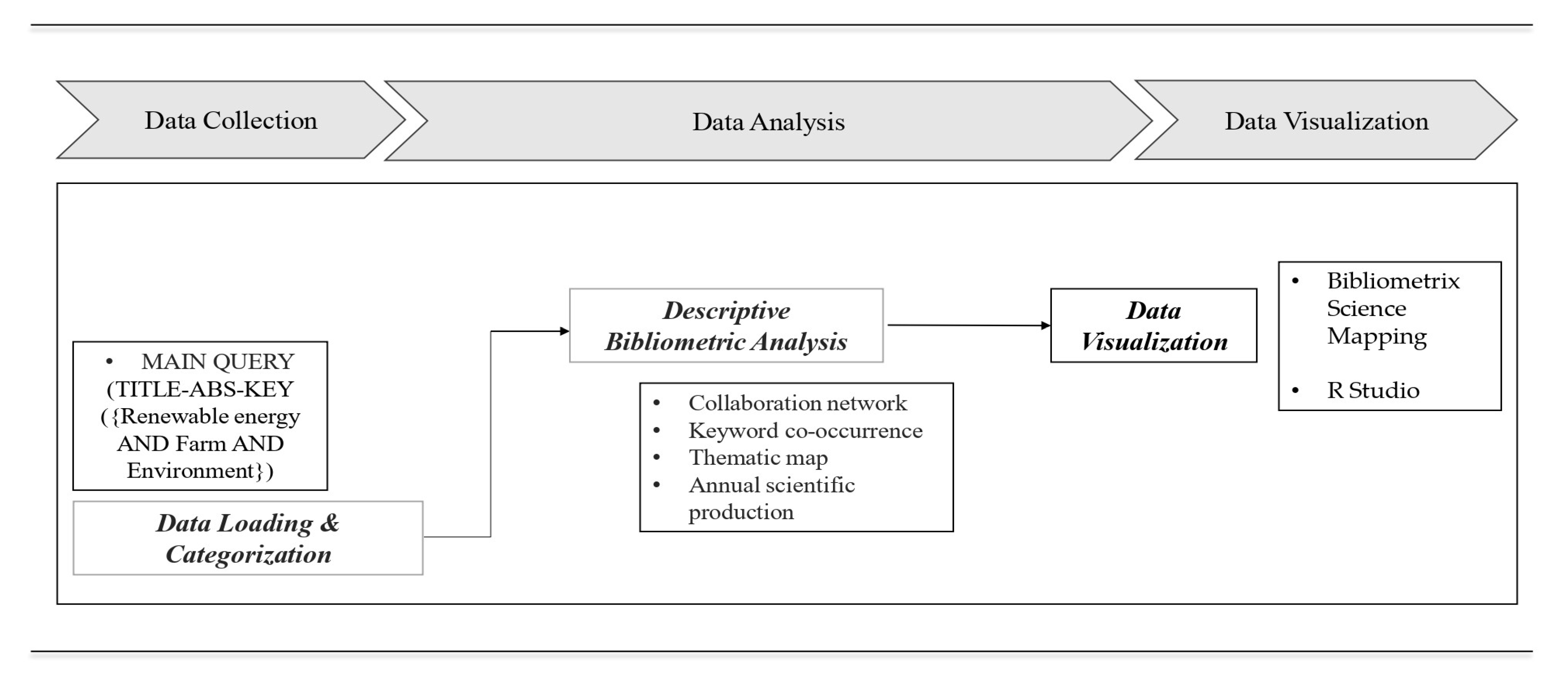
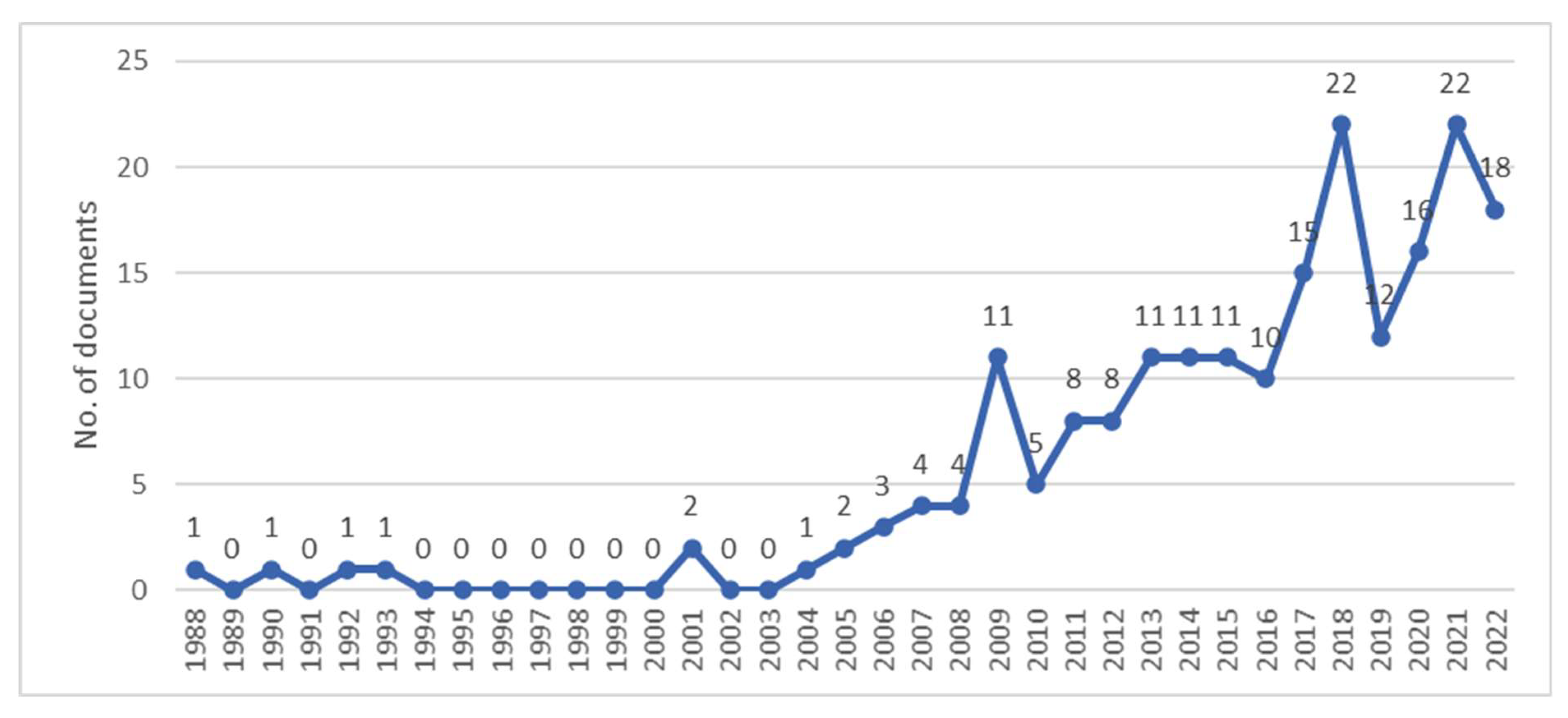
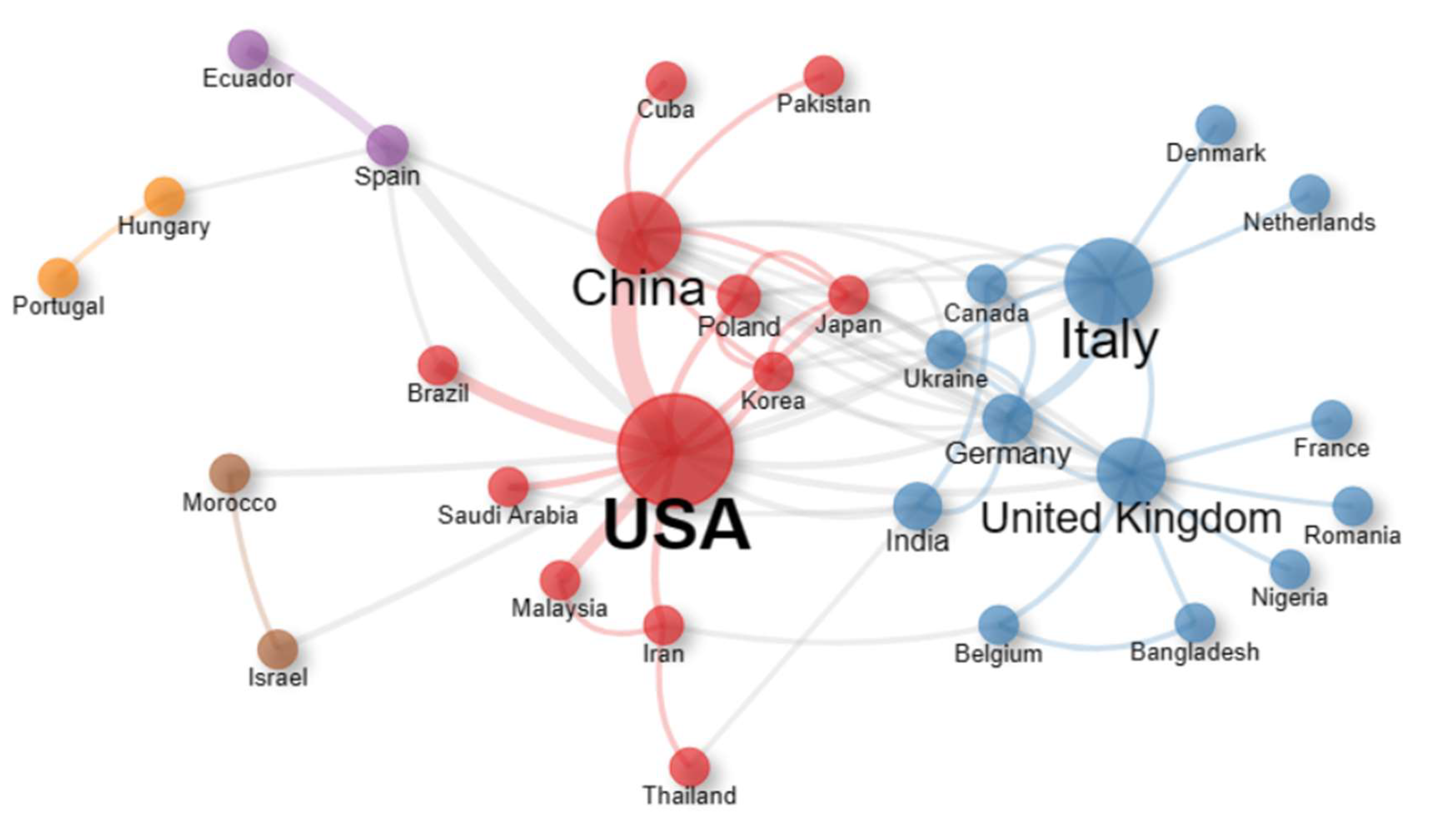
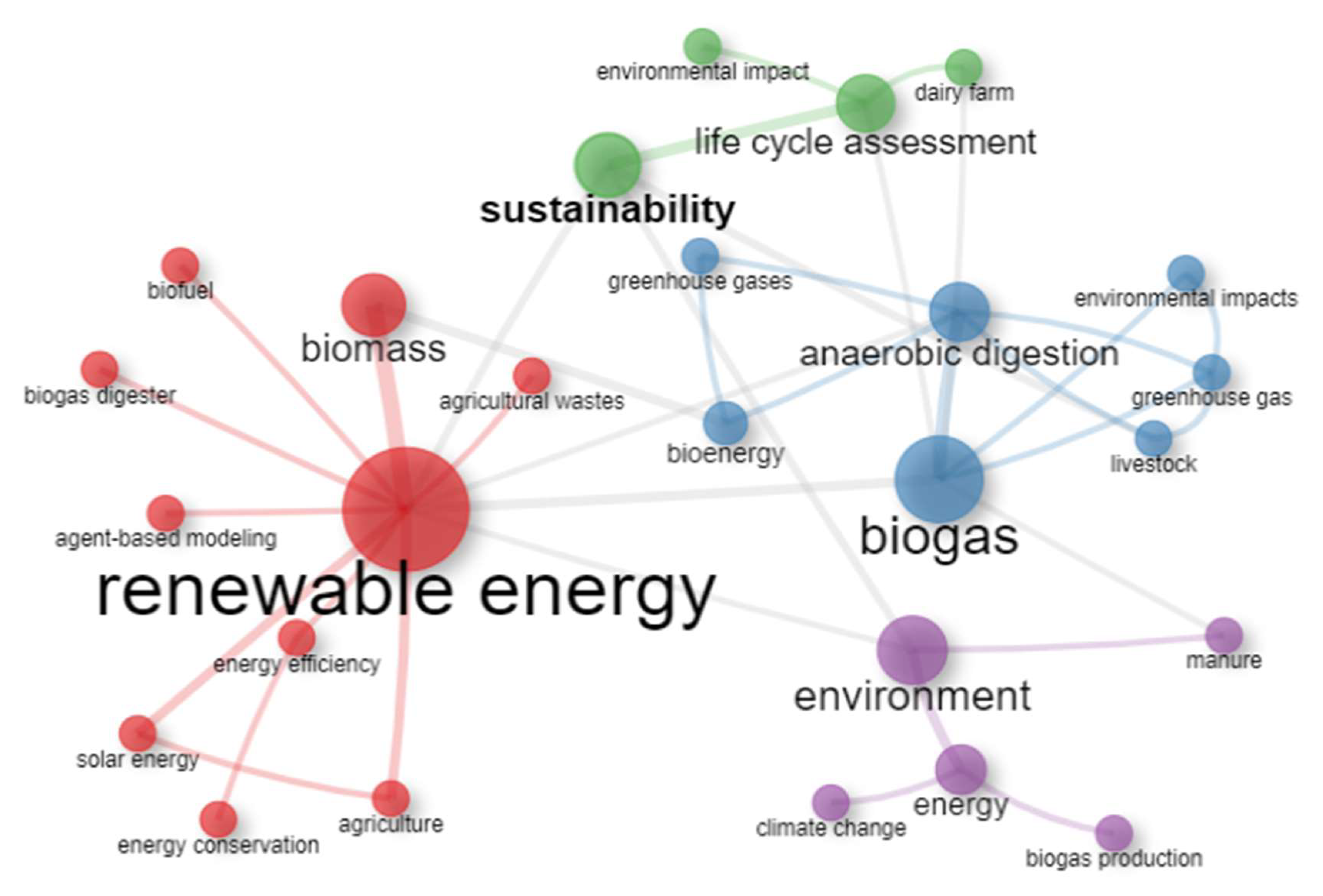

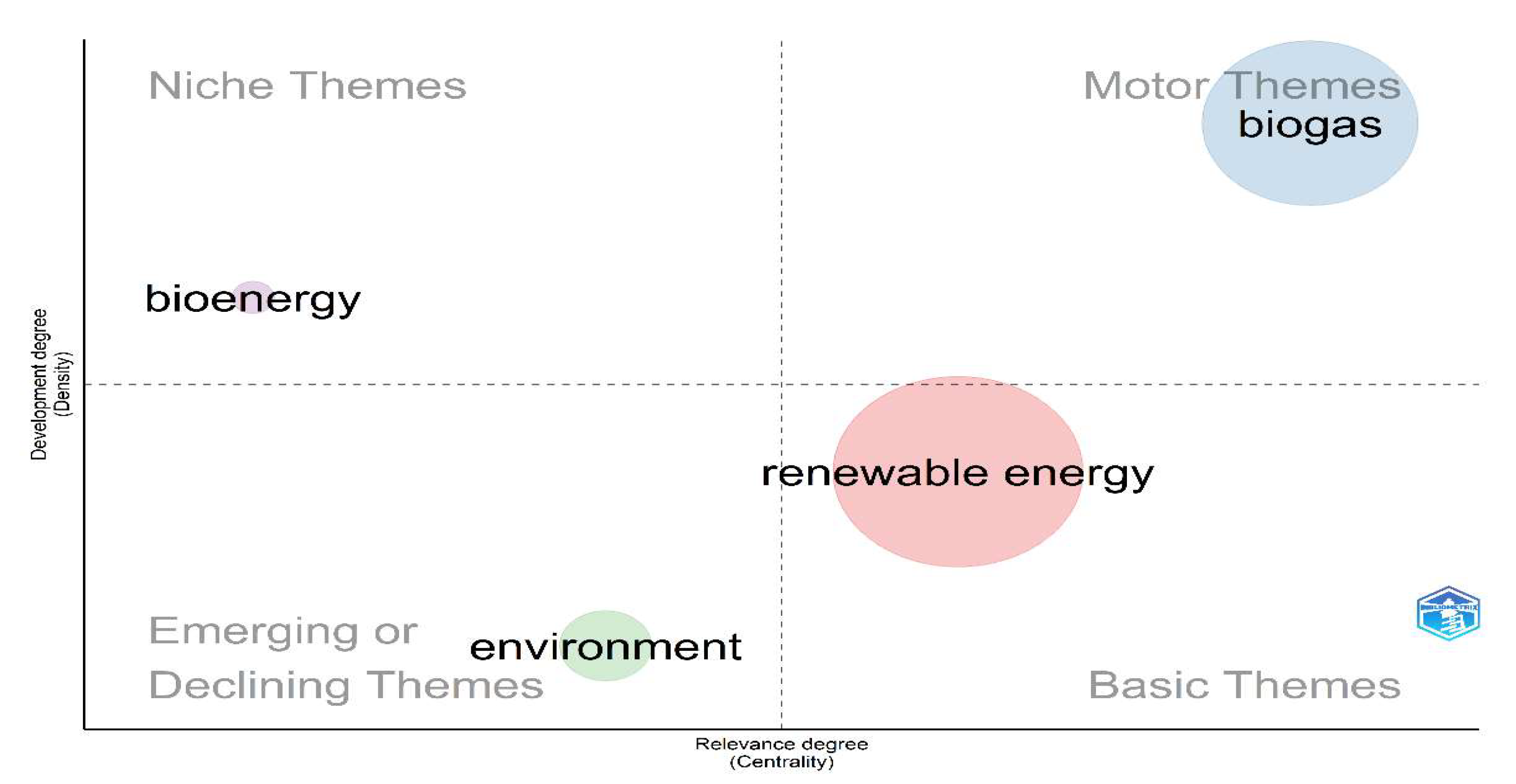
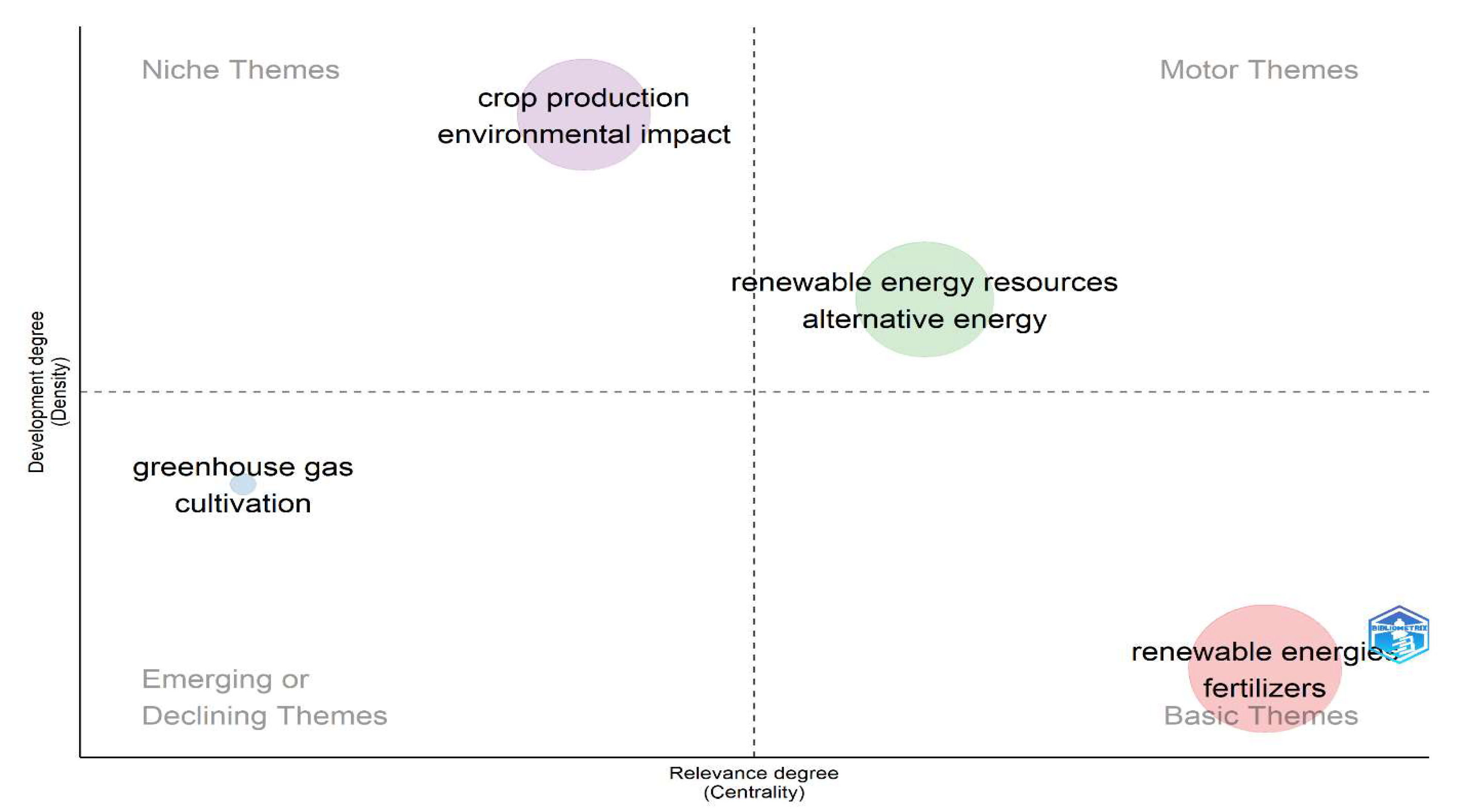
| Description | Results |
|---|---|
| Period | 1988–2022 |
| Documents | 200 |
| References | 8982 |
| Author’s Keywords | 715 |
| Authors | 788 |
| Document Types | |
| article | 142 |
| book | 1 |
| book chapter | 7 |
| conference paper | 33 |
| review | 17 |
| Journal | Publisher | Country | H Index | SJR | TP |
|---|---|---|---|---|---|
| Journal of Cleaner Production | Elsevier | United Kingdom | 232 | 1.92 (Q1) | 8 |
| Sustainability | MDPI | Switzerland | 109 | 0.66 (Q2) | 8 |
| Renewable and Sustainable Energy Reviews | Elsevier | United Kingdom | 337 | 3.68 (Q1) | 7 |
| Energies | MDPI | Switzerland | 111 | 0.65 (Q1) | 5 |
| Science of the Total Environment | Elsevier | The Netherlands | 275 | 1.81 (Q1) | 5 |
| Renewable Energy | Elsevier | United Kingdom | 210 | 1.88 (Q1) | 4 |
| Atmosphere | MDPI | Switzerland | 46 | 0.69 (Q2) | 3 |
| Biomass and Bioenergy | Elsevier | United Kingdom | 189 | 1.01 (Q2) | 3 |
| Fourrages | AFPF | France | 13 | 0.14 (Q4) | 3 |
| Environmental Science and Pollution Research | Spinger | Germany | 132 | 0.83 (Q2) | 3 |
| Country | No. of Documents | Country | No. of Documents |
|---|---|---|---|
| China | 49 | Turkey | 13 |
| USA | 49 | Germany | 12 |
| Italy | 32 | Romania | 11 |
| France | 29 | South Korea | 11 |
| India | 29 | Japan | 9 |
| UK | 28 | Spain | 9 |
| Poland | 19 | Thailand | 9 |
| Iran | 17 | Algeria | 8 |
| Brazil | 15 | Malaysia | 8 |
| Canada | 14 | Netherlands | 8 |
| Country | No. of Doc. | Country | No. of Doc. |
|---|---|---|---|
| China | 20 | USA | 6 |
| India | 20 | Spain | 5 |
| Poland | 16 | Canada | 4 |
| South Korea | 10 | Pakistan | 4 |
| Iran | 9 | Romania | 4 |
| Brazil | 8 | Ecuador | 3 |
| France | 7 | Japan | 3 |
| Italy | 7 | Uzbekistan | 3 |
| UK | 7 | Hungary | 2 |
| Ireland | 6 | Cyprus | 2 |
| Document | DOI | TC | TC per Year |
|---|---|---|---|
| MASSÉ DI, 2011, ANIM FEED SCI TECHNOL | 10.1016/j.anifeedsci.2011.04.075 | 122 | 10.17 |
| CLIFTON-BROWN J, 2017, GCB BIOENERGY | 10.1111/gcbb.12357 | 121 | 20.17 |
| PANDEY J, 2009, ENVIRON MONIT ASSESS | 10.1007/s10661-007-0139-8 | 115 | 8.21 |
| WALMSLEY JD, 2009, FOR ECOL MANAGE | 10.1016/j.foreco.2008.11.015 | 110 | 7.86 |
| BENLI H, 2009, ENERGY BUILD | 10.1016/j.enbuild.2008.09.004 | 110 | 7.86 |
| CHEL A, 2011, AGRON SUSTAINABLE DEV | 10.1051/agro/2010029 | 107 | 8.92 |
| SONI P, 2013, AGRIC SYST | 10.1016/j.agsy.2012.12.006 | 99 | 9.90 |
| ADEH EH, 2018, PLOS ONE | 10.1371/journal.pone.0203256 | 85 | 17.00 |
| BATTINI F, 2014, SCI TOTAL ENVIRON | 10.1016/j.scitotenv.2014.02.038 | 85 | 9.44 |
| VANOTTI MB, 2009, BIORESOUR TECHNOL | 10.1016/j.biortech.2009.02.019 | 78 | 5.57 |
Disclaimer/Publisher’s Note: The statements, opinions and data contained in all publications are solely those of the individual author(s) and contributor(s) and not of MDPI and/or the editor(s). MDPI and/or the editor(s) disclaim responsibility for any injury to people or property resulting from any ideas, methods, instructions or products referred to in the content. |
© 2023 by the authors. Licensee MDPI, Basel, Switzerland. This article is an open access article distributed under the terms and conditions of the Creative Commons Attribution (CC BY) license (https://creativecommons.org/licenses/by/4.0/).
Share and Cite
Pestisha, A.; Gabnai, Z.; Chalgynbayeva, A.; Lengyel, P.; Bai, A. On-Farm Renewable Energy Systems: A Systematic Review. Energies 2023, 16, 862. https://doi.org/10.3390/en16020862
Pestisha A, Gabnai Z, Chalgynbayeva A, Lengyel P, Bai A. On-Farm Renewable Energy Systems: A Systematic Review. Energies. 2023; 16(2):862. https://doi.org/10.3390/en16020862
Chicago/Turabian StylePestisha, Albiona, Zoltán Gabnai, Aidana Chalgynbayeva, Péter Lengyel, and Attila Bai. 2023. "On-Farm Renewable Energy Systems: A Systematic Review" Energies 16, no. 2: 862. https://doi.org/10.3390/en16020862
APA StylePestisha, A., Gabnai, Z., Chalgynbayeva, A., Lengyel, P., & Bai, A. (2023). On-Farm Renewable Energy Systems: A Systematic Review. Energies, 16(2), 862. https://doi.org/10.3390/en16020862







